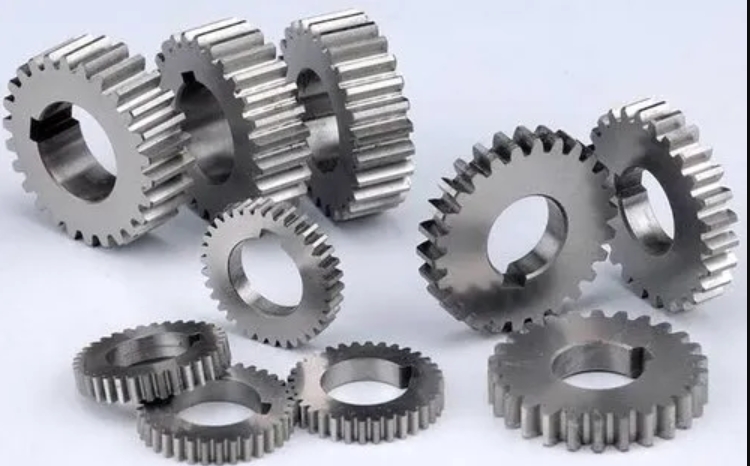This research establishes an analytical model to investigate the meshing dynamics of spur gears with tooth profile modification. The model incorporates Hertzian contact stiffness, bending stiffness, shear stiffness, axial compression stiffness, and fillet foundation stiffness while addressing two geometric design scenarios for profile-shifted gears. Numerical simulations reveal how single and compound tooth profile modifications affect time-varying meshing stiffness (TVMS) and vibration behavior.

1. Mathematical Formulation of TVMS
The total potential energy of a meshing spur gear pair comprises five components:
$$ U = \frac{F^2}{2k} = U_h + U_b + U_s + U_a + U_f $$
where \( k \) represents the combined stiffness, and subscripts denote Hertzian contact (\( h \)), bending (\( b \)), shear (\( s \)), axial compression (\( a \)), and fillet foundation (\( f \)) components. The TVMS for spur gears is expressed as:
$$ k = \begin{cases}
\left[ \frac{1}{k_h} + \sum_{i=1}^2 \left( \frac{1}{k_{b,i}} + \frac{1}{k_{s,i}} + \frac{1}{k_{a,i}} + \frac{1}{k_{f,i}} \right) \right]^{-1} & \text{(single-tooth contact)} \\
\sum_{j=1}^2 \left[ \frac{1}{k_{h,j}} + \sum_{i=1}^2 \left( \frac{1}{k_{b,ij}} + \frac{1}{k_{s,ij}} + \frac{1}{k_{a,ij}} + \frac{1}{k_{f,ij}} \right) \right]^{-1} & \text{(double-tooth contact)}
\end{cases} $$
2. Geometric Relationships for Modified Spur Gears
Critical parameters for profile-shifted spur gears include:
$$ h_{a,i} = (h_a^* + x_i – \Delta y)m_n \quad (i = p,g) $$
where \( x_i \) is the modification coefficient, \( \Delta y \) the tip relief coefficient, and \( m_n \) the normal module. Two geometric cases are analyzed:
| Case | Condition | Stiffness Components |
|---|---|---|
| 1 | Root circle < base circle | $$ \frac{1}{k_b} = \int_{\phi_3}^{\phi_2} \frac{3a_x R_b}{2EL^3} d\phi + \int_{-\phi_1}^{\phi_2} \frac{3(1+\cos\phi_1)}{2EL^3} d\phi $$ |
| 2 | Root circle ≥ base circle | $$ \frac{1}{k_b} = \int_{-\phi_1}^{\phi_5} \frac{3(1+\cos\phi_1)}{2EL^3} d\phi $$ |
3. Dynamic Model of Spur Gear System
A 6-DOF lumped parameter model describes spur gear dynamics:
$$ \begin{cases}
m_p \ddot{x}_p + c_b \dot{x}_p + k_b x_p = -F_m \\
I_p \ddot{\beta}_p = -F_m R_{b,p} – T_p \\
m_g \ddot{x}_g + c_b \dot{x}_g + k_b x_g = F_m \\
I_g \ddot{\beta}_g = -F_m R_{b,g} – T_g
\end{cases} $$
Meshing force \( F_m \) incorporates TVMS and damping:
$$ F_m = k(t) \left[ x_p – x_g + R_{b,g}\beta_g – e(t) \right] + c_m \left[ \dot{x}_p – \dot{x}_g + R_{b,g}\dot{\beta}_g – \dot{e}(t) \right] $$
4. Case Studies
4.1 Single Tooth Modification
Table 1 compares TVMS characteristics under different modification coefficients:
| Modification | TVMS Mean (N/m) | TVMS Std (N/m) | Dynamic Impact |
|---|---|---|---|
| Positive (\( x = +0.5 \)) | 1.48×109 | 3.2×108 | Increased vibration |
| Negative (\( x = -0.5 \)) | 1.64×109 | 2.0×108 | Reduced vibration |
4.2 Compound Modification
For S-gear (\( \Sigma x \neq 0 \)) and s0-gear (\( \Sigma x = 0 \)) modifications:
$$ \text{TVMS variation} = \begin{cases}
+15\% & \text{(Negative S-gear)} \\
-12\% & \text{(Positive S-gear)} \\
\pm 3\% & \text{(s0-gear)}
\end{cases} $$
5. Statistical Vibration Analysis
Key indicators for spur gear dynamic performance:
$$ \begin{aligned}
\text{RMS} &= \sqrt{\frac{1}{N}\sum_{i=1}^N x_i^2} \\
\text{SRA} &= \left( \frac{1}{N}\sum_{i=1}^N |x_i| \right)^2 \\
\text{PPV} &= \max(x_i) – \min(x_i) \\
\text{KV} &= \frac{1}{N}\sum_{i=1}^N \left( \frac{x_i – \bar{x}}{\sigma} \right)^4
\end{aligned} $$
| Modification Type | RMS Change | PPV Change | KV Change |
|---|---|---|---|
| Positive Single | +18% | +22% | +35% |
| Negative Single | -14% | -9% | -18% |
| Negative S-gear | -21% | -25% | -30% |
6. Conclusion
This study demonstrates that tooth profile modification significantly impacts spur gear dynamics:
- Positive single modifications reduce TVMS by 12-15% while increasing vibration amplitudes
- Negative single modifications improve TVMS by 10-14% with 15-20% vibration reduction
- Compound negative S-gear modifications achieve optimal performance: 20-25% TVMS increase and 25-30% vibration reduction
The analytical model provides a foundation for designing high-performance spur gear systems through strategic tooth profile modifications.
